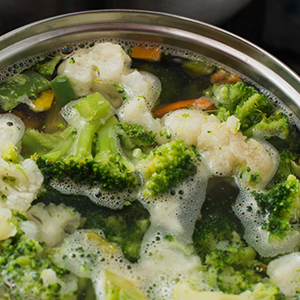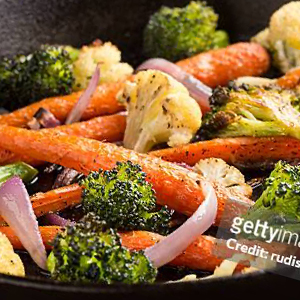
Instead of This, Eat That!
- Home
- Live Well Blog
- Instead of This, Eat That!
Elena’s 3-year-old son Brandon won’t eat veggies. Is there anything Elena can serve instead that has the same nutrition? Grace knows she can eat better, but she doesn’t really like it when her mom keeps telling her what NOT to eat. Why does eating healthy foods have to be so difficult?
Luckily there’s a better way to think about eating healthier. It involves making “trade-offs.” It’s good to remember that it’s not “all or nothing” when it comes to eating healthier. For example, nutritionists recommend eating “whole” wheat bread, but if you prefer wheat or white wheat bread, that’s still healthier than just white bread.
Below are some suggestions on healthier options based on healthfulness, nutrient content, and cooking method. Use these tips to help your family eat a little healthier with simple substitutions!
Instead of This, Eat That for Healthfulness


White Rice
Brown rice, quinoa, barley
Whole grains contain healthy fiber, more nutrients, and are better for blood sugar and cholesterol.
Mayonnaise
Use plain Greek yogurt instead of sour cream or use a mix of mayo and yogurt in dips and salad dressings
Yogurt has a similar texture but has much less fat and also has protein, calcium, and gut friendly bacteria.
Corn or Vegetable Oil
Canola, Olive, or Avocado Oil
Less saturated fat, more healthy fats.
Oil when pan frying
Olive or Avocado oil cooking spray
Less fat and calories.
Oil when making quick breads
Applesauce, mashed banana,
or other fruit
Reduces fat while adding more fiber and vitamins.
Instead of this…
White Rice
Eat that…
Brown rice, quinoa, barley
Why
Whole grains contain healthy fiber, more nutrients, and are better for blood sugar and cholesterol.
Instead of this…
Mayonnaise
Eat that…
Use plain Greek yogurt instead of sour cream or use a mix of mayo and yogurt in dips and salad dressings
Why
Yogurt has a similar texture but has much less fat and also has protein, calcium, and gut friendly bacteria.
Instead of this…
Corn or Vegetable Oil
Eat that…
Canola, Olive, or Avocado Oil
Why
Less saturated fat, more healthy fats.
Instead of this…
Oil when pan frying
Eat that…
Olive or Avocado oil cooking spray
Why
Less fat and calories.
Instead of this…
Oil when making quick breads
Eat that…
Applesauce, mashed banana,
or other fruit
Why
Reduces fat while adding more fiber and vitamins.
Instead of This, Eat That for Variety and Similar Nutrients


Instead of this…
Eat that…
Why
Broccoli, cabbage,
bell peppers, tomatoes
Oranges and other citrus fruits, kiwi, papaya, strawberries, cantaloupe, berries
Rich in Vitamin C
Carrots, sweet potato, spinach, red peppers
Cantaloupe, mango, pumpkin
Rich in Vitamin A
Lean beef, dark meat of chicken
White beans, lentils, firm tofu, kidney beans
Vegetarian sources of iron
Lean beef, pork, chicken, fish
Eggs, cottage cheese and other cheeses, yogurt (especially Greek yogurt), lentils and beans (except green), tofu, nuts*, and seed butters
High in protein
1 cup milk or 1.5 oz cheese
1 cup of soy milk or fortified orange juice, ¾ cup almond milk, 3 cups cooked kale or turnip greens, 3 oz. sardines, 6 tbsp Almond butter*, ¾ cup tofu, 3 tbsp black strap molasses
All servings of food listed have similar amounts of calcium. (Note that you need to eat a very large serving of veggies to equal a serving of dairy.)
*May be a choking hazard for children under 5.
Instead of this…
Broccoli, cabbage,
bell peppers, tomatoes
Eat that…
Oranges and other citrus fruits, kiwi, papaya, strawberries, cantaloupe, berries
Why
Rich in Vitamin C
Instead of this…
Carrots, sweet potato, spinach, red peppers
Eat that…
Cantaloupe, mango, pumpkin
Why
Rich in Vitamin A
Instead of this…
Lean beef, dark meat of chicken
Eat that…
White beans, lentils, firm tofu, kidney beans
Why
Vegetarian sources of iron
Instead of this…
Lean beef, pork, chicken, fish
Eat that…
Eggs, cottage cheese and other cheeses, yogurt (especially Greek yogurt), lentils and beans (except green), tofu, nuts*, and seed butters
Why
High in protein
Instead of this…
1 cup milk or 1.5 oz cheese
Eat that…
1 cup of soy milk or fortified orange juice, ¾ cup almond milk, 3 cups cooked kale or turnip greens, 3 oz. sardines, 6 tbsp Almond butter*, ¾ cup tofu, 3 tbsp black strap molasses
Why
All servings of food listed have similar amounts of calcium. (Note that you need to eat a very large serving of veggies to equal a serving of dairy.)
*May be a choking hazard for children under 5.
Instead of This, Cook Like That for Better Health


Instead of this…
Eat that…
Why
Deep fried chicken, fish, or veggies
Coat with egg and bread crumbs or flour and bake at a high temperature or air fry
Less fat and calories
Boiled veggies
Toss with a bit of oil and seasonings and roast in the oven
Veggies lose less nutrients and turn sweet when boiled, which may appeal to kids.
Steamed veggies
Steam in the microwave by cooking in a covered glass or ceramic container with 1-2 tablespoons of water
Food is more nutrient-rich, looks prettier and tastes better.
Baking a roast or brisket
Use a slow cooker
Inexpensive meats which are healthier, but tend to be tougher, get tender when cooked slowly over low heat. With a slow cooker, you can set it and forget it!
Instead of this…
Broccoli, cabbage,
bell peppers, tomatoes
Eat that…
Oranges and other citrus fruits, kiwi, papaya, strawberries, cantaloupe, berries
Why
Rich in Vitamin C
Instead of this…
Carrots, sweet potato, spinach, red peppers
Eat that…
Cantaloupe, mango, pumpkin
Why
Rich in Vitamin A
Instead of this…
Lean beef, dark meat of chicken
Eat that…
White beans, lentils, firm tofu, kidney beans
Why
Vegetarian sources of iron
Instead of this…
Lean beef, pork, chicken, fish
Eat that…
Eggs, cottage cheese and other cheeses, yogurt (especially Greek yogurt), lentils and beans (except green), tofu, nuts*, and seed butters
Why
High in protein
Instead of this…
1 cup milk or 1.5 oz cheese
Eat that…
1 cup of soy milk or fortified orange juice, ¾ cup almond milk, 3 cups cooked kale or turnip greens, 3 oz. sardines, 6 tbsp Almond butter*, ¾ cup tofu, 3 tbsp black strap molasses